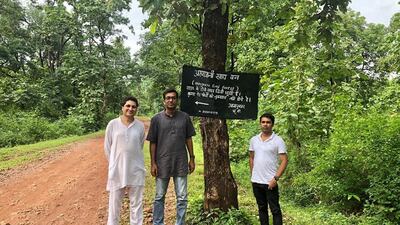Every morning, Sandeep Saxena goes for a walk through the lush “food forest” he created on a patch of barren land in central India more than a decade ago amid mounting concerns about climate change.
He checks the health of the plants and fruit-bearing trees as honeybees flit between their flowers. Chickens scratch through the soil in search of worms and a herd of 60 cows roams freely through the 11,000-hectare forest he has named "Aranyaani".
Mr Saxena, 44, gave up his career as an economic researcher in the United States and returned to India in 2007 after his work revealed to him of the extent of agrarian distress in the country. His goal: to find a remedy for the damage being caused by poor farming practices and climate change.
"I realised our rivers were not flowing once winters were over. The tributaries were flowing but not the rivers. The major reason I found was the kind of agriculture which involved heavy tilling, usage of pesticides and forests being chopped in the name of development. This was totally destroying the soil," he told The National.
At the same time, climate change has resulted in more frequent floods and severe drought, erratic monsoons and the rapid melting of the Himalayan glaciers feed some of India’s major rivers such as the Ganga and Yamuna. Temperatures have been rising, too, crossing 50°C in parts of northern India this summer. At least 15 cities were on the list of world's hottest places for the first time.
A study published in the Proceedings of the National Academy of Sciences in 2017 found that climate change was a factor in more than 59,000 farmer suicides in India over the previous 30 years. It suggested the key culprit could be failing harvests that pushed poor farmers deep into debt.
Faced with recurring crop failure, farmers are in desperate need of new, sustainable methods to produce food.
After returning to India, Mr Saxena spent two years studying the ecological conditions in different regions before selecting a barren piece of land in Sohagpur, in his home state of Madhya Pradesh, to convert into his dream forest.
“As I travelled into interiors of Madhya Pradesh and saw the denuded rocky patches, denuded by mining and left as no good for agricultural purposes, it dawned on me that these were once thriving forests – giving life to small streams that flowed into large rivers,” he says. “I took that as a challenge to convert them into food forests that produce top quality foods.
“Forests have always existed. It is only humans who no longer depend on forests for food. “I wanted to create a forest that grows on its own without the need of tilling, fertilisers, chemicals, or high-tech machinery and gives us natural food.”

Mr Saxena began his experiment on a patch of 8 hectares that he purchased where “the first challenge was to bring some life to the barren land”.
First he planted shrubs to return life to the soil and act as temperature controllers and moisture-trapping plants. Once the shrubs had grown, he planted tall trees that could withstand high temperatures and break through rocks with their roots.
Around these he kept adding progressively shorter trees, including fruit-bearing trees such as papaya and cranberry. In between he planted crops such as sweet potatoes and turmeric
“We kept adding plants that would support each other in handling cold winters, heat and draining excess rainfall,” Mr Saxena said.
By the fourth year, he had a forest with more than 175 types of trees and plants. With land donated by friends in exchange for naturally grown, chemical-free produce, Mr Saxena managed to slowly expand the forest to its current size.
Besides plants, the forest teems with a variety of animal life, including honeybees, earthworms, snakes and birds.
“Earthworms keep the soil channels open. The bees pollinate, and also yield tonnes of honey,” he says.
Importantly, the forest has started yielding income. During peak months, Mr Saxena sells about 10,000 litres of cow milk and pure honey worth Dh20,000.
He is now helping farmers in three other states to grow their own food forests.
“The only way we can fight climate change is by changing the way of our food consumption, agriculture methods and reducing carbon footprint,” he says.
Mr Saxena’s efforts are endorsed by Subhash Palekar, an awarding-winning Indian agriculturist and a long-term advocate of forest farming.
"To restrict global warming, dense forests need to be created in large scale," Mr Palekar told The National.
“However, with the population growth, there is a double demand for food production ... if we convert the cultivated land into dense forests, there would be a food crisis,” he says. Instead, “we can create forests of food that can both restrict carbon dioxide emission as well as give food to the people.”

